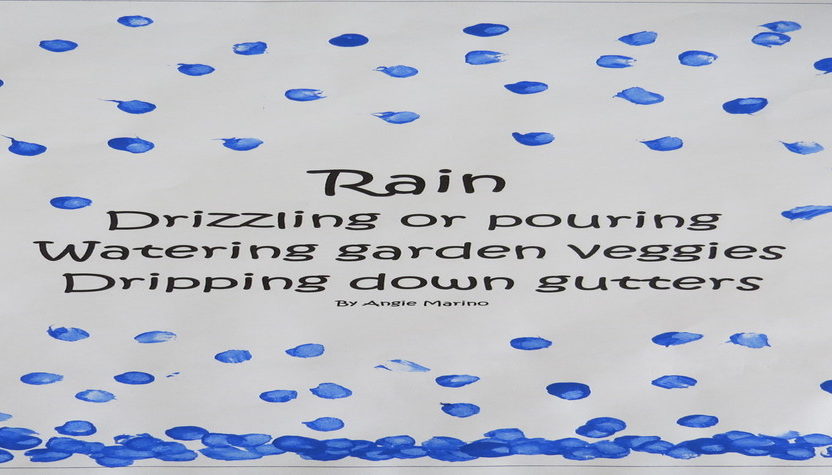Haiku poems are simple for the children to do and fun for them because the ideas are endless! In this poem, I’m going to show you how to teach children how to write a haiku poem. Then, I’m going to include two writing games that focus on syllables.
*This post contains affiliate links. For more information, see my disclosures here.*
Any Theme
Haiku poems go great with ANY theme! If you are focusing on a particular Science, History, Geography or Math lesson, take a break and let the kids write a Haiku poem about the topic! Most recently, my students wrote Haikus about snow!
Younger Writers
Also, if you have younger writers who haven’t quite grasped what syllables are, help them write a Haiku. I did that with my 5 1/2 year old. Here’s his work:

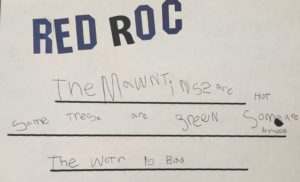
Calendar Pictures
Haikus also go great with old calendar pages (like in my son’s sample above.)
NOW THE LESSON!
What is a Haiku Poem?
- Explain to the children that Haikus originated in Japan and are often used to describe nature.
- Explain that a Haiku is a three line poem in which the 1st line has 5 syllables, the 2nd line has 7 syllables and the 3rd line has 5 syllables.
- Review syllables by clapping 1, 2, 3 and 4 syllable words (i.e. dog, jumpy, excited, energetic)
You can skip steps 4-7, but completing these next steps does help solidify the child’s understanding of a Haiku.
4. Give each student a piece of paper. I like to use this blank page with a border around it.
5. Have them use markers or ABC stickers* to write the word HAIKU at the top.
6. Next, have them draw a Japanese flag.
7. Third, have them use marker or number stickers* to write a 5, 7, and 5 in a vertical line.
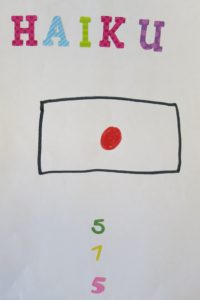
8. On the back, they can draft their Haiku poem. (Because a Haiku is so short, the students write a 1st draft and then a final draft for this prompt.)
NOW TO WRITE!
Have students:
- Choose a Noun, Topic or Theme to write about.
- On the 1st line, write a 5 syllable phrase describing the chosen topic.
- For the 2nd line, write a 7 syllable phrase describing the chosen topic.
- Then, on the 3rd line, write a 5 syllable phrase describing the chosen topic.
- Check their work to make sure they have the correct number of syllables.
Write a Final Draft
- Write the final draft.
- Feel free to print out this Haiku template for students who can write two or this template for students who can only write one haiku.
- For the final draft, leave space at the top for the title.
- Write the final Haiku on each of the three lines.
- Use marker, ABC stickers* or paint to write the title in the space at the top.
A students’ Haiku Poems About Rain
Last spring, I had a small group of students write Haikus about rain! (They got a little carried away with their rain art accent at the end. But it was so fun for them and rewarded them for their work!
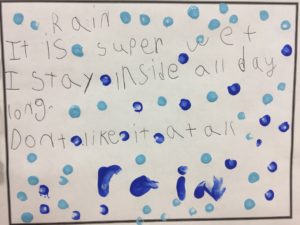
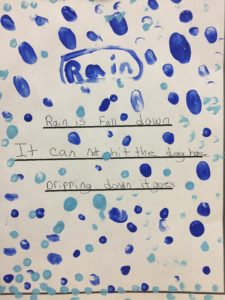
A Student’s Haiku Poem About Teeth

Two Haiku Poems About a Calendar Picture
These two Haiku poems went along with a calendar page, like the one at the top.
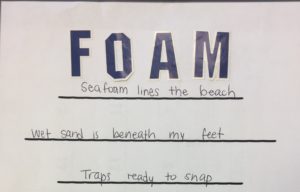
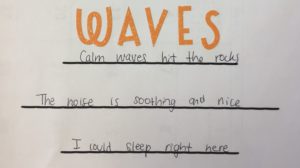
Print the Lesson
Here’s the full lesson for you to print out and use.
Haiku Poems: GAME ONE!
You can play these two games before or after writing Haiku poems. Additionally, they go really well with poems that rhyme and require a certain number of syllables for each line. In short, these two games focus on counting syllables. Both games are excellent for helping children solidify their ability to hear and count syllables in words, phrases and sentences.
SYLLABLES IN WORDS
The first games is focuses on words.
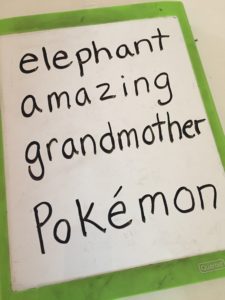
Common Core State Standards
NOTE: This game can address the following Common Core Standards: CCSS.ELA-LITERACY.RF.K.2, RF.K.2.B, RF.1.2, RF.1.3.E, RF.3.3.C and RF.4.3.A
One Magnetic Spinner
In order to play this game, you need one magnetic spinner*. If you haven’t read my full post on the winner spinner you won’t want to miss it! It gives you a long list of game ideas that are so easy to run and super fun for the kids. Check out the full post here.
NOW TO PLAY!
First, start off by drawing one circle on the whiteboard. Divide it into 4 sections and write the numbers 1, 2, 3 and 4.

Next, for smaller groups (up to 8) I divide the large whiteboard into 4 sections. A pair is assigned to each section.

Larger Groups
For larger groups, (or if I don’t have a large whiteboard or chalkboard), I divide the group into pairs. I give each pair a small white board, dry erase marker and a sock to serve as an eraser. You can purchase a class pack on Amazon*.



Now to Play!
- First, one child spins a number. Set a phone or timer to 1 minute.
- Second one partner from each pair takes a turn listing as many words as he or she can that have that number of syllables. For example, if a child spins a 3 their list might look like this:

3. Third, the students have 60 seconds to complete their list. Once they’ve completed their list, they don’t say anything. They just hold up their white board.

4. Fourth, check to make sure each word indeed has the number of syllables spun.
If you see one word that does not have the correct number of syllables, hold up one finger, two words, two fingers, three words, three fingers, four words, four fingers. If all the words fit, give a thumbs up so that the child can put a tally on his/her board for each word that he/she has written correctly.
5. Laslty, continue play until everyone has had a turn to spin or your allotted time runs out!
Print the Instructions
Here are the instructions for you to print out and use.
Haiku Poems: GAME TWO
The second game focuses on syllables in phrases. Again, this game goes really well with poetry, specifically a Haiku poem or a rhyme that requires a certain number of syllables for each line.
Common Core State Standards
NOTE: This game can address the following Common Core Standards: CCSS.ELA-LITERACY.RF.K.2, RF.K.2.B, RF.1.2, RF1.3.E, RF.3.3.C and RF.4.3.A
The Magnetic Spinner
Again, you need one magnetic spinner*.
Setting up the game:
First, start off by drawing one circle on the whiteboard. Divide the circle into 4 or 8 sections. Write the numbers 5-8 or 4-11.


Next, for smaller groups (up to 8) I divide the large whiteboard into 4 sections. A pair is assigned to each section.

Or, for larger groups, (or if I don’t have a large whiteboard or chalkboard), I divide the group into pairs. I give each pair a small white board, dry erase marker and a sock to serve as an eraser. You can purchase a class pack on Amazon*.



Now to play!
- First, one child spins a number.
- Second, one partner in each pair takes a turn writing a phrase that has that number of syllables. For example, if a child spins a 5, their phrase might look like this:

3. Third, once the students have completed a phrase, they don’t say anything. Instead, they just hold up their whiteboards.

4. Fouth, check to make sure each phrase indeed has the number of syllables spun. If a phrase doesn’t, shake your head “no” and smile. The student continues to correct the phrase. When the phrases fits, give a thumbs up and the child puts a tally on his or her board. Students who finish their phrase quickly can write more phrases, earning more points until each pair has completed at least one phrase.
5. Lastly, continue play until everyone has had a turn to spin or your allotted time runs out!
Print the Instructions
Here are the instructions for you to print out and use.


Again, we played these two games after writing Haiku poems. You can also play them after writing Limericks.
